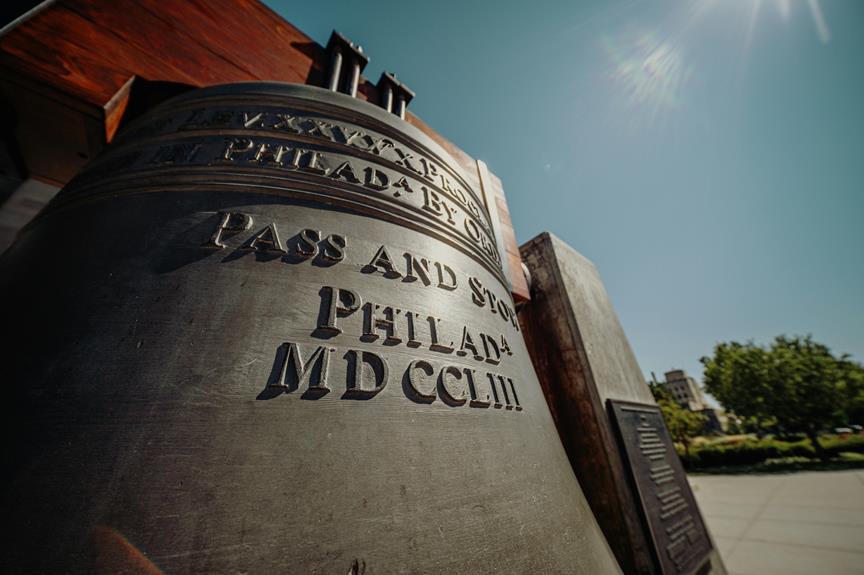The Holocaust Memorial in Berlin, Germany, stands as a solemn reminder of one of the darkest chapters in human history. Its stark design and vast expanse provoke contemplation and evoke a range of emotions from those who walk through its haunting corridors. Beyond its physical presence, the memorial serves as a catalyst for profound discussions on memory, responsibility, and the enduring impact of historical traumas. As visitors navigate its labyrinthine paths, they are confronted with an unspoken challenge to confront the past and consider its implications for the present and future.
Key Takeaways
- Designed by Peter Eisenman, the memorial features 2,711 concrete slabs symbolizing the Holocaust victims.
- Open daily with free admission, the site offers guided tours, wheelchair access, and multilingual information booklets.
- Evokes emotional responses and cultural reflection on the Holocaust's significance, serving as a symbol of remembrance and anti-intolerance.
- Educational programs include workshops, online resources, and tailored school programs to promote understanding globally.
- Maintained through regular preservation efforts, the memorial is part of a network of global initiatives promoting remembrance and solidarity.
History of the Memorial
The history of the Holocaust Memorial in Berlin, Germany dates back to the early 1990s when the idea for a memorial to commemorate the victims of the Holocaust was first proposed. This significant initiative was a response to the need for a tangible symbol of remembrance for the millions who perished during one of the darkest periods in human history.
The historical background of the memorial is deeply rooted in the collective memory of the atrocities committed during the Holocaust. The architectural significance of the memorial lies in its ability to evoke a sense of somber reflection and contemplation. The design of the memorial, which consists of 2,711 concrete slabs of varying heights arranged in a grid pattern over undulating ground, serves as a poignant reminder of the systematic extermination of six million Jewish people by the Nazis.
The memorial's location in the heart of Berlin also adds to its historical importance, as it stands not far from where the Nazi regime once orchestrated its heinous crimes. This proximity to sites of historical significance further emphasizes the memorial's role as a solemn tribute to the victims of the Holocaust and a stark warning against the dangers of intolerance and hatred.
Architectural Design
Symbolizing solemn remembrance and historical reflection, the architectural design of the Holocaust Memorial in Berlin intricately weaves together elements of starkness and contemplation. The innovative structure of the memorial, designed by architect Peter Eisenman, consists of 2,711 concrete slabs of varying heights and sizes arranged in a grid pattern across a sloping field. This design creates a sense of disorientation and unease as visitors navigate through the maze-like pathways between the towering slabs, symbolizing the chaos and confusion of the Holocaust.
The artistic representation of the memorial is further enhanced by the play of light and shadow created by the slabs, evoking a somber and introspective atmosphere. The starkness of the concrete, with its minimalist aesthetic, serves as a poignant reminder of the brutal reality of the Holocaust. The sheer scale of the memorial, covering an area of over 19,000 square meters, emphasizes the magnitude of the tragedy and the millions of lives lost.
Symbolism and Significance
Indicative of profound historical reflection, the Holocaust Memorial in Berlin encapsulates layers of symbolism and significance through its architectural composition and spatial arrangement. Symbolism permeates every aspect of the memorial, starting with its design of 2,711 concrete slabs of varying heights and sizes, symbolizing the unpredictability and disorder of the Holocaust. As visitors walk through the undulating maze of slabs, they experience a sense of disorientation and isolation, mirroring the experiences of the victims.
The memorial's underground Information Centre further deepens the symbolism by providing historical context and personal stories, emphasizing remembrance and education.
The significance of the Holocaust Memorial lies in its ability to evoke emotional responses and encourage reflection on the atrocities of the past. By creating a space that is both abstract and immersive, the memorial prompts visitors to contemplate the consequences of intolerance and indifference. It serves as a poignant reminder of the millions of lives lost during the Holocaust and the importance of preserving their memory.
Through its symbolic design and powerful message of remembrance, the Holocaust Memorial stands as a testament to the resilience of the human spirit and a call to uphold the values of freedom and justice for future generations.
Visiting Information
Upon arrival at the Holocaust Memorial in Berlin, visitors will find essential information regarding opening hours, accessibility, and guided tours at the visitor center located near the entrance. The memorial is open to the public every day from 10:00 am to 8:00 pm, allowing ample time for visitors to explore and reflect. Admission to the memorial is free of charge, aligning with the principle that remembrance should be accessible to all. However, for those interested in a more in-depth experience, guided tours are available for a fee. These tours provide valuable insights into the history and significance of the memorial, enhancing the visitor's understanding of the site.
In terms of accessibility, the memorial is designed to accommodate visitors with mobility impairments. Wheelchair access is available throughout the site, ensuring that all individuals can pay their respects and engage with the memorial. Additionally, information booklets in multiple languages are provided at the visitor center, allowing international visitors to understand the memorial's context and importance.
For those planning a visit, it is recommended to check the official website for any updates on opening hours or special events. By offering both free access and guided tours for a fee, the Holocaust Memorial in Berlin aims to provide a meaningful and inclusive experience for all visitors.
Memorial's Impact
The Holocaust Memorial in Berlin, Germany has left a profound impact on visitors and serves as a poignant reminder of the atrocities of the past. The emotional response elicited by the memorial is palpable, with many visitors expressing feelings of sadness, contemplation, and even anger as they walk through the stark concrete slabs that make up the monument. The sheer scale of the memorial, with its 2,711 concrete blocks of varying heights, creates a sense of disorientation and unease, mirroring the chaos and confusion of the Holocaust itself.
Beyond individual emotional responses, the memorial also prompts a broader cultural reflection on the events of the Holocaust and their significance in contemporary society. As visitors navigate the maze-like structure, they are forced to confront the dark chapters of history and consider the implications for the present and future. The memorial serves as a powerful symbol of remembrance and a call to action against intolerance and injustice.
Educational Programs
In light of its profound impact on visitors, the Holocaust Memorial in Berlin, Germany has established educational programs aimed at furthering understanding and awareness of the historical significance behind the monument. These initiatives play an essential role in ensuring that the memory of the Holocaust remains vivid and relevant for future generations.
The educational programs offered at the Holocaust Memorial in Berlin include:
- Interactive Workshops: Through interactive workshops, participants have the opportunity to engage with historical content in a hands-on and immersive manner. These workshops often involve activities such as group discussions, role-playing exercises, and guided tours led by knowledgeable educators. By actively involving visitors in the learning process, these workshops help foster a deeper understanding of the complexities surrounding the Holocaust.
- Virtual Resources: The Holocaust Memorial in Berlin also provides a range of virtual resources for those unable to visit the site in person. These resources include online exhibitions, virtual tours, educational videos, and downloadable materials such as lesson plans and informational brochures. By making these resources accessible online, the memorial extends its educational reach to a global audience, promoting awareness and understanding on an international scale.
- Educational Programs for Schools: The memorial offers tailored educational programs for schools, designed to meet the specific needs of students at different grade levels. These programs often include guided tours, interactive activities, and age-appropriate educational materials. By engaging students in meaningful ways, the memorial aims to instill a sense of empathy, tolerance, and historical consciousness in the next generation.
Controversies and Criticisms
Amidst the recognition and acclaim the Holocaust Memorial in Berlin, Germany has garnered for its educational initiatives, certain controversies and criticisms have surfaced regarding its design and interpretation. One of the main points of debate revolves around the ethics of the memorial's design. Some critics argue that the abstract nature of the memorial, with its grid of concrete slabs, fails to effectively convey the gravity and horror of the Holocaust. They believe that a more explicit representation would better honor the victims and educate visitors about the atrocities that occurred. On the other hand, supporters of the memorial's design contend that its abstract nature allows for a more personal and reflective experience, prompting visitors to contemplate the meaning of loss and remembrance in their own way.
The public response to the Holocaust Memorial in Berlin has been mixed. While many visitors find the memorial to be a moving and powerful experience, others have criticized it for being too abstract or insufficient in conveying the enormity of the Holocaust. Some have also raised concerns about the commercialization of the memorial site, citing the presence of nearby cafes and shops as being inappropriate given the memorial's somber purpose.
| Controversies and Criticisms | |
|---|---|
| Ethics Debate | |
| Abstract design criticized for not effectively conveying the horror of the Holocaust | |
| Supporters argue for a more personal and reflective experience | |
| Public Response | |
| Mixed reactions from visitors | |
| Concerns about commercialization of the memorial site |
Maintenance and Preservation
Ensuring the long-term maintenance and preservation of the Holocaust Memorial in Berlin, Germany is essential for its continued significance as a site of remembrance and education. The memorial, with its 2,711 concrete slabs or 'stelae,' serves as a poignant reminder of the atrocities committed during the Holocaust.
To maintain this powerful symbol, various restoration efforts and conservation techniques are employed:
- Regular Inspection and Cleaning: Routine inspections are conducted to assess the condition of the memorial and identify any signs of deterioration. Cleaning procedures, using gentle techniques to preserve the integrity of the concrete, help prevent the accumulation of dirt and pollutants that could harm the structure over time.
- Repair and Restoration: As the memorial ages, restoration efforts are essential to address any structural issues or damage that may occur due to environmental factors or wear and tear. Skilled craftsmen work diligently to repair cracks, chips, or other forms of deterioration, ensuring that the memorial remains intact for future generations.
- Conservation Planning: Developing a detailed conservation plan is vital for the long-term preservation of the memorial. This plan outlines strategies for monitoring, maintenance, and emergency response, helping to safeguard the integrity of the site and ensure its continued importance as a place of reflection and education.
Global Commemoration
A worldwide network of memorials and educational initiatives collectively commemorates the Holocaust, fostering a global dialogue on remembrance and lessons learned. International solidarity plays an essential role in connecting these remembrance initiatives across borders, ensuring that the memory of the Holocaust is preserved and honored on a global scale.
Holocaust memorials and museums can be found in various countries, serving as poignant reminders of the atrocities committed during World War II. These sites not only pay tribute to the millions of victims but also serve as educational tools to prevent such horrors from happening again. Through exhibitions, educational programs, and outreach efforts, these institutions aim to raise awareness and promote understanding among diverse populations worldwide.
The significance of global commemoration lies in its ability to unite people from different backgrounds in a shared commitment to never forget the past. By fostering international solidarity, these remembrance initiatives emphasize the importance of standing together against hatred, discrimination, and genocide. Through collaborative efforts, individuals and communities around the world can work towards a future built on mutual respect, tolerance, and peace. The memory of the Holocaust serves as a stark reminder of the consequences of indifference and inaction, urging people to actively engage in upholding human rights and dignity for all.
Frequently Asked Questions
How Are the Names of Holocaust Victims Honored at the Memorial?
Names of Holocaust victims are honored at the memorial through the installation of symbolic stones, each representing a life lost during this tragic period in history.
These stones serve as poignant reminders of the individuals who perished, ensuring that their memories are preserved and respected.
The act of memorializing the names in such a manner carries deep symbolic significance, allowing visitors to pay their respects and reflect on the atrocities that occurred during the Holocaust.
Are There Any Events or Ceremonies Held at the Memorial?
Events and ceremonies play a crucial role in honoring historical events and promoting community participation. They serve as crucial opportunities for reflection, education, and remembrance. These gatherings encompass a variety of activities like lectures, performances, commemorations, and discussions that help preserve shared memories. By bringing people together, these events offer a chance to pay tribute to the past, derive lessons from it, and ensure that history's mistakes are not repeated.
Through these communal activities, individuals can unite in their efforts to commemorate the past and draw meaningful insights from it. These events create spaces for dialogue, learning, and collective action, fostering a sense of shared responsibility for preserving historical narratives. Ultimately, they contribute to the preservation of cultural heritage and the promotion of a more informed and empathetic society.
Is There a Specific Reason Behind the Memorial's Location in Berlin?
The location of memorials often bears historical significance and can be influenced by urban planning considerations. In the case of the Holocaust Memorial in Berlin, the choice of location may have been guided by the city's history as the capital of Nazi Germany during World War II.
Additionally, urban planning factors such as visibility, accessibility, and symbolic value could have played a role in determining the memorial's specific site within the city.
Can Visitors Leave Personal Tributes or Messages at the Memorial?
Visitors can indeed leave personal tributes and messages at the memorial, allowing for a tangible expression of their emotional impact. This act of remembrance not only honors the victims but also fosters a sense of connection and reflection.
Are There Opportunities for Volunteer Work at the Memorial Site?
Volunteer opportunities at the site provide individuals with a chance to contribute to memorial operations and engage in educational programs. These programs offer participants the ability to gain a deeper understanding of historical significance while supporting the memorial's mission.
Volunteers may assist with guided tours, educational workshops, or administrative tasks. By participating in these opportunities, individuals can actively contribute to preserving the memory of historical events while promoting education and remembrance.
Conclusion
To sum up, the Holocaust Memorial in Berlin serves as a solemn tribute to the millions of lives lost during the Holocaust.
As the saying goes, 'Those who cannot remember the past are condemned to repeat it.'
The memorial serves as a stark reminder of the consequences of hatred and intolerance, urging visitors to reflect on the importance of preserving freedom and justice for future generations.


